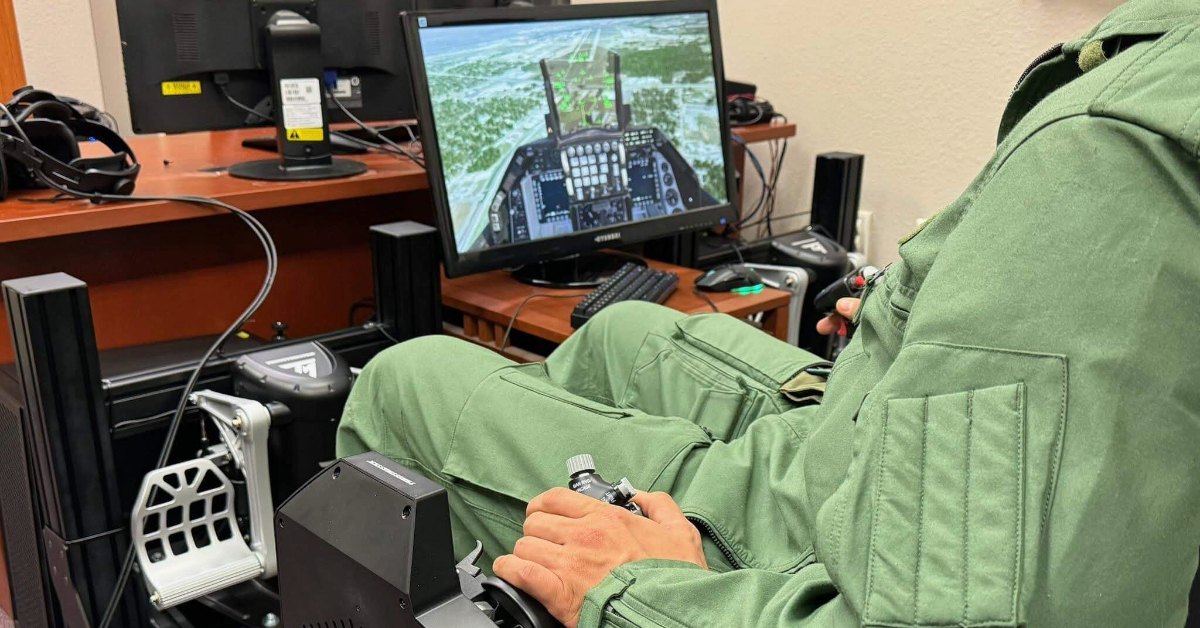November 27, 2023 (ORLANDO, FL) – To keep pace with an evolving threat landscape, virtual training technologies are playing an essential role in how the Department of Defense (DoD) maintains readiness. Today, the Defense Innovation Unit (DIU) is leveraging the cutting-edge capabilities, scalability, and accessibility of commercial game engines to deliver modernized individual pilot flight training.
Legacy training methods require extensive government resources and rely heavily on aircraft flight hours and instructor-pilot interaction.
In response to these challenges, DIU and Air Education and Training Command (AETC) are developing a multi-phase process to modernize and increase efficiency of pilot training through existing commercial capabilities in a program called Pilot Training Transformation (PTT). PTT is leveraging commercial gaming technologies, such as XR headsets, PC’s, and replica cockpit systems as a low-cost, low-footprint, and agile method for flight training.
In 2022, DIU supported AETC in fielding 225 immersive training devices across all four U.S. Air Force undergraduate training sites. These devices operate on a DIU-prototyped containerized commercial cloud network; they not only augment student simulator training, but also they capture data, which is ingested into a cloud-based learning management system that assists the instructors in managing grades, syllabus progression, and schedules.
According to Alex Horn, DIU program manager, “AETC has set the bar for modern flying training programs. This new technology, now fielded, provides students and instructors with the tools needed to adapt to the challenges of the resource constrained environment where we now operate. Despite the many challenges in budget and manning, we are able to produce pilots better, faster, and cheaper than ever before." Commercial partners on the project included Vertex Solutions, Discovery Machine, CAE, and Google.
After the successful deployment of the immersive training devices and the associated technology stack, and leveraging significant commercial R&D advancements in mixed-reality, AETC again harnessed DIU’s Commercial Solutions Opening to prototype a multi-place mixed reality flight simulator that will replace their aging TH-1H helicopter simulators. This new simulator uses much of the same technology as the immersive training device, but presents a fully interactive cockpit replica in mixed reality, and is poised for potential Federal Aviation Administration certification. This device will soon be integrated into the TH-1H training syllabus as the primary aircrew training device for the 23rd Flying Training Squadron at Ft Novasel, AL.

USAF TH-1H pilots evaluating the Multi-place Mixed Reality flight simulator.
A new program, called Virtual Training for Air Dominance (VTRAD), was built off PTT. This effort introduces a new technology provider, Metrea Simulations, to deliver the software platform, and is expanding to include a high-fidelity, virtual F-16 flight model and cockpit, an advanced simulation and training program designed to optimize actual mission effectiveness.
“Through DIU, Det 24 is rapidly developing extended reality training solutions for the future of fighter bomber pilot training,” said Lt Col Steve “Tiger” Briones, Commander, Det24. “Leveraging the synthetic environment for part-task training and mission recreation will translate into training efficiencies. This effort broadens the spectrum of training devices available for fast-jet flying”
Virtual Training for Air Dominance (VTRAD)
Training initial pilot training students using commercial gaming technology is one thing, but training graduate-level fighter pilots, and operational jet pilots is another. To deliver such solutions in the domain of fast-jet training, new capabilities in commercial gaming software and synthetic training environments are needed.
The Virtual Training for Air Dominance (VTRAD) program, sponsored by 19th Air Force/Detachment 24 (“Pilot Training Next”) and DIU, is now prototyping a high-fidelity next-gen simulation engine capable of powering any virtual training platform simply using a personal gaming computer. This innovation allows training units to no longer need to fully rely on the large and costly full flight simulators for all of their virtual training requirements.
Initial use-cases for this new, lightweight simulation engine include AETC’s new Fighter/Bomber Fundamentals course in the T-38C jet trainer, and an F-16 training capability to support the Ukrainian Air Force training taking place in Tucson, AZ. This new simulation capability is designed to be massively extensible and scalable to support joint, tactical, multi-domain training.
The DoD and U.S. government partners on this project include AETC, 19 Air Force/Det24 PTN, AZANG (162FW), TXANG (149FW), and SAF/IAPW. Commercial partners are Vertex and Metrea Simulations.
